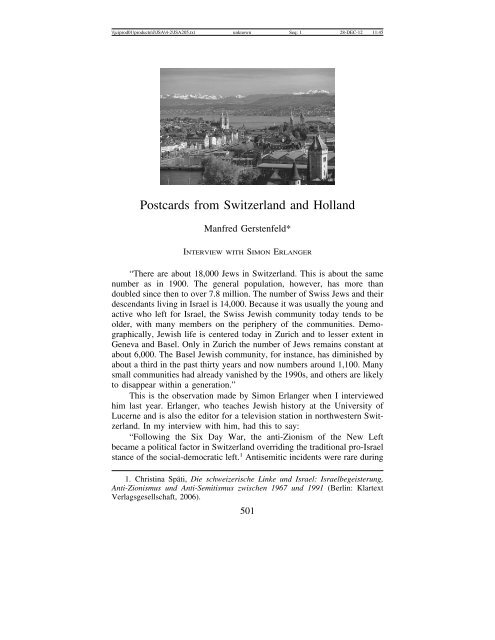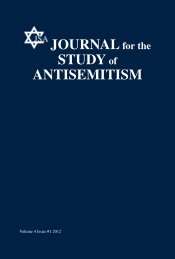Postcards from Switzerland and Holland - Journal for the Study of ...
Postcards from Switzerland and Holland - Journal for the Study of ...
Postcards from Switzerland and Holland - Journal for the Study of ...
Create successful ePaper yourself
Turn your PDF publications into a flip-book with our unique Google optimized e-Paper software.
\\jciprod01\productn\J\JSA\4-2\JSA205.txt unknown Seq: 1 28-DEC-12 11:45<strong>Postcards</strong> <strong>from</strong> <strong>Switzerl<strong>and</strong></strong> <strong>and</strong> Holl<strong>and</strong>Manfred Gerstenfeld*INTERVIEW WITH SIMON ERLANGER“There are about 18,000 Jews in <strong>Switzerl<strong>and</strong></strong>. This is about <strong>the</strong> samenumber as in 1900. The general population, however, has more th<strong>and</strong>oubled since <strong>the</strong>n to over 7.8 million. The number <strong>of</strong> Swiss Jews <strong>and</strong> <strong>the</strong>irdescendants living in Israel is 14,000. Because it was usually <strong>the</strong> young <strong>and</strong>active who left <strong>for</strong> Israel, <strong>the</strong> Swiss Jewish community today tends to beolder, with many members on <strong>the</strong> periphery <strong>of</strong> <strong>the</strong> communities. Demographically,Jewish life is centered today in Zurich <strong>and</strong> to lesser extent inGeneva <strong>and</strong> Basel. Only in Zurich <strong>the</strong> number <strong>of</strong> Jews remains constant atabout 6,000. The Basel Jewish community, <strong>for</strong> instance, has diminished byabout a third in <strong>the</strong> past thirty years <strong>and</strong> now numbers around 1,100. Manysmall communities had already vanished by <strong>the</strong> 1990s, <strong>and</strong> o<strong>the</strong>rs are likelyto disappear within a generation.”This is <strong>the</strong> observation made by Simon Erlanger when I interviewedhim last year. Erlanger, who teaches Jewish history at <strong>the</strong> University <strong>of</strong>Lucerne <strong>and</strong> is also <strong>the</strong> editor <strong>for</strong> a television station in northwestern <strong>Switzerl<strong>and</strong></strong>.In my interview with him, had this to say:“Following <strong>the</strong> Six Day War, <strong>the</strong> anti-Zionism <strong>of</strong> <strong>the</strong> New Leftbecame a political factor in <strong>Switzerl<strong>and</strong></strong> overriding <strong>the</strong> traditional pro-Israelstance <strong>of</strong> <strong>the</strong> social-democratic left. 1 Antisemitic incidents were rare during1. Christina Späti, Die schweizerische Linke und Israel: Israelbegeisterung,Anti-Zionismus und Anti-Semitismus zwischen 1967 und 1991 (Berlin: KlartextVerlagsgesellschaft, 2006).501
\\jciprod01\productn\J\JSA\4-2\JSA205.txt unknown Seq: 2 28-DEC-12 11:45502 JOURNAL FOR THE STUDY OF ANTISEMITISM [ VOL. 4:501<strong>the</strong> 1970s but began to multiply after <strong>the</strong> Lebanon War <strong>of</strong> 1982. By <strong>the</strong>n,<strong>for</strong> example, cemeteries were desecrated almost on a regular basis. 2 During<strong>the</strong> 1980s <strong>and</strong> 1990s, a militant extreme right also emerged. Due to <strong>the</strong>country’s liberal laws, Holocaust deniers <strong>and</strong> revisionists used <strong>Switzerl<strong>and</strong></strong>as a base. This changed <strong>for</strong> <strong>the</strong> better by 1994 with <strong>the</strong> introduction <strong>of</strong> an‘anti-Racism law.’ By 1987, when <strong>the</strong> First Intifada broke out, most <strong>of</strong> <strong>the</strong>Swiss mainstream media had become hostile toward Israel <strong>and</strong> <strong>the</strong> generalatmosphere <strong>for</strong> Jews had deteriorated. Since <strong>the</strong>n <strong>Switzerl<strong>and</strong></strong> has seen anunprecedented upsurge <strong>of</strong> both traditional antisemitism <strong>and</strong> its newer disguise,‘anti-Israelism.’“A 2007 poll found that over 86 percent <strong>of</strong> Swiss Jews deplore mediabias <strong>and</strong> distortions. They consider that this has contributed to a majordecrease in personal <strong>and</strong> communal security. There are many verbal <strong>and</strong>sometimes physical attacks. They are rarely recorded. In 2007, <strong>the</strong> SIG, <strong>the</strong>Swiss Federation <strong>of</strong> Jewish Communities, set up an institution to collectdata <strong>and</strong> provide statistics. Ano<strong>the</strong>r organization, CICAD, reports on anti-Semitic incidents in <strong>the</strong> western, French-speaking part <strong>of</strong> <strong>Switzerl<strong>and</strong></strong>. MostSwiss Jewish communities employ important security measures.Erlanger continued:“A specific Swiss element in <strong>the</strong> rise in antisemitism was <strong>the</strong> affair <strong>of</strong><strong>the</strong> dormant Jewish bank accounts during 1992-1998. For many years,descendants <strong>of</strong> Holocaust victims had claimed accounts that <strong>the</strong>ir murderedrelatives had held in Swiss banks. This issue was raised immediately after<strong>the</strong> war <strong>and</strong> <strong>the</strong>n again in <strong>the</strong> 1950s. After payment <strong>of</strong> small sums by <strong>the</strong>banks to Jewish organizations <strong>and</strong> <strong>the</strong> Swiss Federation <strong>of</strong> Jewish Communities,<strong>the</strong> matter had been considered settled. Restitution issues werereopened in Europe in <strong>the</strong> 1990s. Concerning <strong>Switzerl<strong>and</strong></strong>, this developedinto a controversy about <strong>the</strong> country’s record during World War II. Thisincluded economic collaboration with <strong>the</strong> Nazis, laundering <strong>of</strong> stolen gold,<strong>and</strong> <strong>the</strong> anti-Jewish refugee policy. The government initially refused tocooperate with Jewish claimants, as did <strong>the</strong> banks. Later on, major Jewishorganizations <strong>and</strong> <strong>the</strong> US government became involved. This led to <strong>the</strong>worst Swiss <strong>for</strong>eign policy crisis in decades. Ultimately, a financial settlementwas reached between Swiss banks <strong>and</strong> Jewish organizations. TheSwiss <strong>the</strong>n had to face a past that did not correspond to <strong>the</strong> heroic selfimage<strong>the</strong>y had cherished. The myth <strong>of</strong> neutrality, while at <strong>the</strong> same timeresisting Nazi Germany, was largely discarded. Many Swiss felt coerced bya hostile outside world—mainly Jews <strong>and</strong> Americans—seeking to damage2. Cf. Hans Stutz, Rassistische Vorfälle in der Schweiz (Zurich: GRA-Stiftunggegen Rassismus und Antisemitismus, 1992).
\\jciprod01\productn\J\JSA\4-2\JSA205.txt unknown Seq: 3 28-DEC-12 11:452012] POSTCARDS FROM SWITZERLAND AND HOLLAND 503<strong>Switzerl<strong>and</strong></strong>’s self-image <strong>for</strong> political <strong>and</strong> financial purposes. Thereupon, asizable rise occurred in overt antisemitism <strong>and</strong> anti-Americanism.“In 1996, <strong>the</strong>n Swiss president Pascal Delamuraz referred to <strong>the</strong> restitutiondebate as ‘blackmail’ <strong>and</strong> asked whe<strong>the</strong>r Auschwitz was located in<strong>Switzerl<strong>and</strong></strong>. This gave antisemitism a new respectability. The debate on <strong>the</strong>Swiss wartime record relegitimized antisemitism in many parts <strong>of</strong> society<strong>and</strong> unleashed an antisemitic wave. There was ano<strong>the</strong>r antisemitic wave in2001. Then economics minister <strong>and</strong> federal counselor Pascale Couchepinsuggested, along with <strong>the</strong> Swiss Federation <strong>of</strong> Jewish Communities, toabolish <strong>the</strong> prohibition <strong>of</strong> shechita [ritual slaughter]. Not only militantanimal rights groups, but much <strong>of</strong> <strong>the</strong> public was outraged by this proposal.Articles <strong>and</strong> letters to <strong>the</strong> editor openly used traditional antisemitic languagethat would have been unacceptable earlier. The government dropped<strong>the</strong> proposal to keep internal peace.”Concerning <strong>the</strong> future, Erlanger concluded our interview with thiswarning: “Many young Swiss Jews have emigrated over <strong>the</strong> decades, whilemany o<strong>the</strong>rs have opted out <strong>of</strong> <strong>the</strong> organized Jewish community <strong>and</strong> <strong>of</strong>tenout <strong>of</strong> any <strong>for</strong>m <strong>of</strong> Jewish life. The future <strong>of</strong> <strong>the</strong> community—however wellestablished <strong>and</strong> affluent—is cause <strong>for</strong> concern.”INTERVIEW WITH ELMA DRAYER“September 11, 2001, was a turning point <strong>for</strong> <strong>the</strong> Jews in <strong>the</strong> Ne<strong>the</strong>rl<strong>and</strong>s.On September 12 <strong>of</strong> that year, I visited psychologist Bloeme Evers<strong>for</strong> a story about a synagogue in <strong>the</strong> western part <strong>of</strong> Amsterdam, <strong>of</strong> whichshe is <strong>the</strong> inspirational founder. I was still somewhat in shock <strong>from</strong> watching<strong>the</strong> attacks in <strong>the</strong> United States on TV all day. Evers said to me, ‘Thiswill have repercussions <strong>for</strong> us Jews.’ I asked her, ‘What are you talkingabout? Muslims executed <strong>the</strong> attacks yesterday.’ I didn’t underst<strong>and</strong> whatshe meant at all.“Afterwards, I thought a lot about what she said. Within three days, <strong>the</strong>perpetrators became <strong>the</strong> victims <strong>and</strong> <strong>the</strong> victims had become perpetrators. Achange <strong>of</strong> roles had taken place. Since <strong>the</strong>n, I have seen similar examples <strong>of</strong>this phenomenon.“In <strong>the</strong> weeks following 9-11, <strong>the</strong>re was unrest in Amsterdam West,where many Muslims live. A few weeks later, Moroccan youngsters threwstones at Jews who were coming out <strong>of</strong> <strong>the</strong> synagogue. I still had to finishmy article on <strong>the</strong> synagogue. I called <strong>the</strong> police to check what was happening.The police spokesman said, ‘I would prefer if you don’t pay too muchattention to this incident. These people are already in an unfavorable position.’He wasn’t speaking about <strong>the</strong> Jews at whom <strong>the</strong> stones were thrown,but about <strong>the</strong> Muslims who threw <strong>the</strong> stones.”
\\jciprod01\productn\J\JSA\4-2\JSA205.txt unknown Seq: 4 28-DEC-12 11:45504 JOURNAL FOR THE STUDY OF ANTISEMITISM [ VOL. 4:501The writer <strong>of</strong> <strong>the</strong>se paragraphs, Elma Drayer, worked at <strong>the</strong> Dutchdaily Trouw <strong>from</strong> 2001 until 2010 as an editor <strong>and</strong> columnist. Now she is afreelance journalist. “This incident must be seen in a larger context,” Drayersays. “In recent years, one hears public statements that were deemedsocially unacceptable in <strong>the</strong> Ne<strong>the</strong>rl<strong>and</strong>s after <strong>the</strong> Second World War. After<strong>the</strong> war, antisemitism was heavily suppressed. Now people speak about <strong>the</strong>Jews in an increasingly condescending way. This is also related to <strong>the</strong>changed position <strong>of</strong> Israel. One cannot separate <strong>the</strong> anti-Israel mood <strong>from</strong>antisemitism. The antisemitism, which was latent after <strong>the</strong> Second WorldWar, now has reemerged with great <strong>for</strong>ce.“To this has to be added that many people do not take Muslims seriously,but view <strong>the</strong>m with pity. This is a new <strong>for</strong>m <strong>of</strong> <strong>the</strong> ancient paternalism.Yet if one states that this construct plays a major role in <strong>the</strong> judgmentabout Israel, one receives responses like, ‘You are never allowed to sayanything about Israel because <strong>the</strong>n you are immediately termed anantisemite.’ ”Drayer continues, “In a column about <strong>the</strong> conference <strong>of</strong> Holocaustdeniers in Teheran in 2006, I wrote: ‘Maybe I missed it, but I haven’t seenany angry Jews shouting in our streets, marching toward <strong>the</strong> IranianEmbassy. I didn’t hear <strong>the</strong>m chant ‘All Muslims are liars.’ Nowhere have Iseen an effigy <strong>of</strong> Ahmadinejad in flames. Yet, this conference was anincredible provocation. On <strong>the</strong> o<strong>the</strong>r h<strong>and</strong>, <strong>the</strong> Muslim world requires farless provocation in order to explode. One only has to remember <strong>the</strong> reactionsto <strong>the</strong> Danish Muhammed cartoons. His followers started riots; tens <strong>of</strong>people were killed as a result. Yet many Dutch bloggers <strong>and</strong> opinion makersexpressed <strong>the</strong>ir solidarity with <strong>the</strong> Muslims.“In many places, <strong>the</strong>re was a call to respect Muslim sensitivities. Weshould underst<strong>and</strong> that one should not joke about <strong>the</strong>m <strong>and</strong> our cartoonistsshould show more restraint. There were no similar expressions <strong>of</strong> support<strong>for</strong> <strong>the</strong> Jews when stones were thrown at <strong>the</strong>m. The always-alert opinionmakers <strong>and</strong> bloggers kept <strong>the</strong>ir pens quiet.”Drayer cites ano<strong>the</strong>r issue: “In 2007, a report <strong>from</strong> <strong>the</strong> Center <strong>for</strong>In<strong>for</strong>mation <strong>and</strong> Documentation on Israel [CIDI] was published. It gave anuanced view <strong>of</strong> antisemitic incidents in <strong>the</strong> Ne<strong>the</strong>rl<strong>and</strong>s, which hadincreased in 2006 by 64%. The three main national ‘quality’ papers, <strong>of</strong>which my own is one, did not publish this in<strong>for</strong>mation. The Amsterdamdaily Het Parool published <strong>the</strong> report on <strong>the</strong> opinion page, as if antisemitismis an opinion with which one can agree or disagree.“I wrote a column about that. I explained how antisemitic incidentswere registered, what was included as such <strong>and</strong> what was not. I also wrotethat <strong>the</strong> CIDI did not register critical opinions about Israel as antisemitic, anapproach that I agree with. CIDI also does not include antisemitic remarks
\\jciprod01\productn\J\JSA\4-2\JSA205.txt unknown Seq: 6 28-DEC-12 11:45506 JOURNAL FOR THE STUDY OF ANTISEMITISM [ VOL. 4:501immigrants because <strong>the</strong>y are prejudiced. I consider that statement veryantisemitic. On <strong>the</strong> o<strong>the</strong>r h<strong>and</strong>, I receive many positive reactions <strong>from</strong> readers,which <strong>of</strong>fers a welcome balance.“I’ve read <strong>the</strong> Hamas Charter, which promotes <strong>the</strong> murder <strong>of</strong> all Jews.Yet people do not care to find out what is written in it. One <strong>of</strong> <strong>the</strong> <strong>of</strong>t-heardcomparisons in <strong>the</strong> Ne<strong>the</strong>rl<strong>and</strong>s is that <strong>of</strong> Jews <strong>and</strong> Muslims. A falseimpression is given that Muslims are similarly <strong>the</strong> victims <strong>of</strong> <strong>the</strong> Dutchpeople as <strong>the</strong> Jews once were. It is expressed as: ‘Islamophobia is <strong>the</strong> newantisemitism.’“For many years now, I have lived near a synagogue in Amsterdam.When <strong>the</strong>re are services on Saturdays, police are on guard. This doesn’tshock anyone in <strong>the</strong> neighborhood. Yet it is sc<strong>and</strong>alous that this isnecessary.”This portion <strong>of</strong> <strong>the</strong> essay is an adaptation <strong>of</strong> an interview with Drayer by ManfredGerstenfeld, <strong>from</strong> Gerstenfeld’s The Decay: Jews in a Rudderless Ne<strong>the</strong>rl<strong>and</strong>s(2010).*Manfred Gerstenfeld is emeritus chair (2000 to 2012) <strong>and</strong> member <strong>of</strong> <strong>the</strong> Board <strong>of</strong>Fellows <strong>of</strong> <strong>the</strong> Jerusalem Center <strong>for</strong> Public Affairs. He has authored fifteen books,edited five, <strong>and</strong> is a frequent JSA contributor <strong>and</strong> founding JSA board member.














